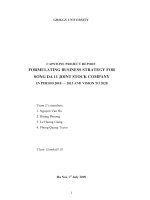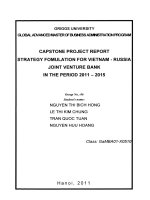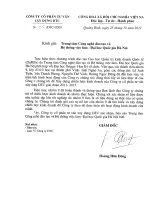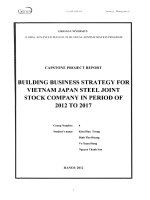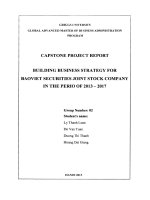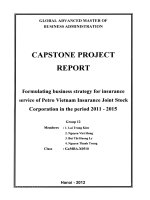Business strategy for An Binh commercial joint stock bank in the period 2011 - 2015
Bạn đang xem bản rút gọn của tài liệu. Xem và tải ngay bản đầy đủ của tài liệu tại đây (1.81 MB, 96 trang )
CAPSTONE PROJECT REPORT
BUSINESS STRATEGY
FOR AN BINH COMMERCIAL
JOINT STOCK BANK
IN THE PERIOD 2011 - 2015
Group number: 4
Student’s name: 1, VU THU LAP
2, NGUYEN THI PHI LOAN
3, TO DUY LAM
4, TRAN DINH LOC
5, LE MAI CANH
Class: GaMBA01C02
HO CHI MINH CITY 2011
2011 GLOBAL ADVANCED MBA PROGRAM (Class C02) Group No.4
GRIGGS UNIVERSITY
GLOBAL ADVANCED MASTER OF BUSINESS ADMINISTRATION PRORGAM
CAPSTONE PROJECT REPORT
BUSINESS STRATEGY
FOR AN BINH COMMERCIAL
JOINT STOCK BANK
IN THE PERIOD 2011 - 2015
Group number: 4
Student’s name:
1, VU THU LAP
2, NGUYEN THI PHI LOAN
3, TO DUY LAM
4, TRAN DINH LOC
5, LE MAI CANH
Class: GaMBA01.C02
HO CHI MINH CITY 2011
GaMBA01.C02 ACKNOWLEDGMENT – CAPSTONE PROJECT REPORT
ACKNOWLEDGEMENT
First of all, our group would like to thank sincerely to Center For
Education Technology & Career Development of Vietnam National
University, and Griggs University who help us acquired knowledge
through the program of Global Advanced Master of Business
Administration.
We would like to thank sincerely and deeply to all teachers who
have enthusiasm to guide us to fulfill the capstone project report as well as
big-hearted teaching, assisting, and facilitating for us to complete this
course.
We also send our sincere thanks to ABBank’s board of leaders,
classroom management members, and GaMBA01.C02 classmates had
helped, encouraged, and supported our group to complete this capstone
project report as well as complete the GaMBA’s program.
ON BEHALF OF GROUP 4
GROUP LEADER
VU THU LAP
GaMBA01.C02 LETTER OF CONFIRMATION – CAPSTONE PROJECT REPORT
LETTER OF COMFIRMATION
All data in the project "Business strategy of An Binh joint stock
commercial bank for the period 2011-2015" related to ABBank’ activities
from 2006 to October 2010 is cited in the annual reports of ABBank and it
has been approved by ABBank ‘s leader.
Ho Chi Minh city, March 1
st
2011
For AN BINH JOINT STOCK COMMERCIAL BANK
Signed by
Mr. NGUYEN CONG CANH
DEPUTY DIRECTOR GENERAL
GaMBA01.C02 TABLE OF CONTENTS – CAPSTONE PROJECT REPORT
TABLE OF CONTENTS
Page
Acknowledgements
Letter of confirmation
Table of contents
INTRODUCTION ………………………………………………………… 1
CHAPTER I ………………………………………………………… 4
I, Theoretical basis 5
1,Concepts, role of strategy and business strategy 5
1.1, Concept of strategy 5
1.2, Strategies at different levels within an organisation …… 6
1.3, The role of business strategy 6
2, The strategic building process 7
2.1, The strategic formulation process ………………………………… 7
2.1.1, Determination of the mission and of the organization ……. 8
2.1.2, Determination of the goals of the organization …………… 8
2.1.3, Determination of the strategic objectives ……………………. 9
2.1.3.1, The internal factors ………………………………………… 10
2.1.3.2, The external factors ………………………………………… 10
2.1.4, Analysis the business environment of firm 11
2.1.4.1- The impacts of external environment for business strategy 11
2.1.4.1.1, Macro environment 11
2.1.4.1.2, Competiors 12
2.1.4.1.3, The quality and capabilities of companies in the industry 13
2.1.4.1.4, Market demand …………………………………………… 13
2.1.4.1.5, Customers 13
2.1.4.1.6, Suppliers 14
2.1.4.2, Assessment of environmental impacts …………………… 14
2.1.4.3, Internal analysis …………………………………………. 14
2.1.4.4, Value chain of the organisation analysis ……………. 15
2.1.4.4.1, The primary activities 15
2.1.4.4.2- Support activities …………………………………… 15
GaMBA01.C02 TABLE OF CONTENTS – CAPSTONE PROJECT REPORT
2.1.5, Financial analysis ………………………… ……………… 15
2.1.6, The rotation index 15
2.1.7, Organizational culture and reputation analysis 15
2.2, Implementation of strategy ………………………………… 16
II, The methods of research 16
1, Method of data collection 16
1.1, By referring to a document 17
1.2, From the experiments 17
1.3- From non-experimental data (questionnaire survey) 17
2, Method of comparison 17
2.1- Comparison of relative movement 17
2.2- Absolute comparison 18
3, Method ofstatistical description 18
4, Method of SWOT analysis 18
5, SWOT Matrix 18
6, Method of Five Forces Analysis 19
7- Method of Quantitative Strategic Planning Matrix (QSPM) …… 20
Summary of Chapter I 20
CHAPTER II …………………………………………………………. 21
I, General introduction of ABBank 22
1, Introduction ………………………………………………… 22
2, Products and services …………………………………………… 22
2.1, For individual customers ………………………………… 22
2.2, For corporate customners 23
2.3, Special customers in electric sector ……………………………. 23
3, The formation and development of ABBank 23
4, Structure of shareholders ………………………………………… 24
5, Organization structure of ABBank 25
5.1- Board of Directors …………………………………………… 26
5.2, Board of Supervisory 27
5.3, Executive Board 27
GaMBA01.C02 TABLE OF CONTENTS – CAPSTONE PROJECT REPORT
5.4, The Council, Committee of the Board 27
5.4.1, Credit Council 27
5.4.2, Assets and Liabilities Management Commitee (ALCO) 27
5.4.3, Risk Monitoring Committee 27
6, Business network ………………………………………… 28
II, Results of operations of ABBank in the period 2006 to 2010 28
1- Some key indicators of business from 2006-2010 of ABBank 28
2, Characteristic activities of ABBank 30
III, Analysis ABBank‘s business activity 31
1, SWOT analysis of the current operating environment of ABBank 31
1.1- Opportunities …………………………………………………… 31
1.1.1, The economy growth is continuous at high speed 31
1.1.2, Globalization and international economic integration 32
1.1.3, The legal environment for banking activities have been
increasingly improved 32
1.1.4, Population size and structure are favorable for the development of
banking services 33
1.1.5, Vietnam's society and politics are stable 33
1.2, Threats ………………………………………………… 33
1.2.1, The increase in competitive pressure in the banking sector 33
1.2.2, Pressures in keeping and expanding in the local market share 34
1.2.3, Competition labor market is increasingly fierce 34
1.2.4, Pressure on increasing charter capital, the management capabilibity
of commercial banks in compliance with the international standards
and rules (Basel II) by the State Bank of Viet Nam’s regulations 34
1.2.5, Customers become increasingly more demanding for banking services 35
1.3 - Matrix of environmental factors assessment 35
2, Analysis of the internal ABBank 36
2.1- Strengths …………………………………………………………… 36
2.1.1, The advantage of equity 36
2.1.2, Foreign and domestic trategic partners are financial and economic
institutions with prestige and strong financial resources 36
GaMBA01.C02 TABLE OF CONTENTS – CAPSTONE PROJECT REPORT
2.1.3, A wide distribution network 37
2.1.4, Risk management system and supervision system 37
2.1.5, Employees with force capable, experienced and high qualitified 37
2.1.6, Executive capacity 37
2.2, Weaknesses …………………………………………………………… 37
2.2.1, Low effective of using capital 37
2.2.2, Distribution channels 37
2.2.3, Competitive advantage 37
2.2.4, Service qulity 38
2.2.5, Marketing activities 38
2.3- Matrix of the internal analysis 38
3, Analysis competitors ……………………………………………………. 39
4 - Some forecasts of banking operations from 2010 to 2015 43
4.1- Key issues is addressed in the development period 2011-2020 43
4.1.1- For all commercial banking system of Vietnam 43
4.1.2- For state-owned commercial banks. 44
4.1.3- For joint stock comercial Banks ………………………………. 44
4.1.4- For the non-banking institutions 45
4.2-The general direction of Vietnam's banking by 2020 45
4.2.1, Competitions …………………………………………………… 45
4.2.2, Health and stability ……………………………………………… 45
4.2.3, Transparency, Disclosure 46
4.2.4, Easy access 46
4.2.5, International integration 46
Summary of Chapter II ……………………………………………………… 47
CHAPTER III …….………………………………………………………. 48
I, Strategies of ABBank in the period 2011 – 2015 49
1, Orientation of business strategy for ABBank in the period 2011 – 2015 49
1.1- General orientations (general goals) 49
1.2- Guideline 49
1.3- Orientation some basic norms in the period 2011-2015 49
GaMBA01.C02 TABLE OF CONTENTS – CAPSTONE PROJECT REPORT
1.3.1- Equity 50
1.3.2- Total Assets 50
1.3.3- The total capital mobilization 50
1.3.4- Total outstanding loans to the economy 50
1.3.5- Return on equity (ROE) 50
1.3.6- CAR 50
1.3.7- Number of branch / transaction devisions 50
1.3.8- Strong research and development of products and services 50
1.3.9- Establishment representative offices or branches 50
2, Strategy formulation 52
2.1, Financial capacity stratergy 53
2.2, Technology capacity stratergy ………………………………… 54
2.3, Management capacity stratergy ……………………………… 54
2.4, Stratergy of organizational structure and network development 55
2.4.1, Organizational structure construction ……………………… 55
2.4.2, Network development ……………………………………………… 55
2.5, Strategy for products quality and the new products development 56
2.6, Corporation stratergy ………………….……………………… 56
2.7, Branding and marketing stratergy ………………………………. 56
2.8, Human resource stratergy ………………………………… 57
3, Selection of stratergy and specific solutions ……………………… 58
3.1, QSPM analysis …………………………………………………… 58
3.2, Some of other main reasons 68
3.2.1, Human resources ……………………………………………… 68
3.2.2, Products quality …………………………………………………… 69
3.2.3, Business network ……………………………………………… 70
3.3, Specific group of solutions ………………………………………. 71
3.3.1, Solutions for capital ……………………………………………… 71
3.3.2, Solutions for network development stratergy 72
3.3.3, Solutions for products quality …………………………………… 75
3.3.4, Solutions of human resources development …………………… 76
II, Determining the time to implement the strategy …………… …… … 78
GaMBA01.C02 TABLE OF CONTENTS – CAPSTONE PROJECT REPORT
1, The 1
st
period 78
2, The second period 79
3, Steps to develop and implement strategies ……………………………… 79
III, Some recommendations 80
1, For Government, State Bank of Vietnam and concerned ministries 80
2, For ABBank 81
Summary of Chapter III …………………………………………………… 82
CONCLUSION ……………………………………………………………… 83
REFERENCES ……………………………………………………………… 85
GaMBA01.C02 CAPSTONE PROJECT REPORT
LIST OF TABLES, GRAPHS
No
Title of tables, graphs
Page
TABLES
1
Table 2-1.
Activities of An Binh joint stock commercial bank from 2006 to
2010
28
2
Table 2-2.
GDP growth rate in period 2005-2009
31
3
Table 2-3. Matrix of environmental factors assessment of ABBank
35
4
Table 2-4. Matrix of the internal analysis
38
5
Table 2.5- Position of ABBank in the joint stock commercial bank system
39
6
Table 2-6. Matrix of competitors comparison
41
7
Table 3-1. Orientation of ABBank’s basic norms for the period 2010-2015
50
8
Table 3-2. Table of SWOT matrix and TOWS matrix
52
9
Table 3.3- QSPM for selecting the strategic SO group (intensive growth
strategy)
58
10
Table 3.4 - QSPM for selecting strategic ST group (Widespread growth
strategy)
63
GRAPHS
1
Some graphs of key activities of An Binh joint stock bank from 2006 to 2010
29
a
Graph of total assets
29
b
Graph of Equity
29
c
Graph of deposits
29
d
Graph of loans
30
e
Graph of EBT
30
2
Graph of comparison between ABBank, DongABank and ACB
42
3
Some graphs of ABBank’s basic norms from 2011 - 2015
51
a
Graph of Equity and Total assets form 2011 – 2015
51
b
Graph of Deposits and Loans from 2011 – 2015
51
GaMBA01.C0209 Capstone Project Report
1
INTRODUCTION
After the global economic crisis in 2008, many countries are evaluating its
socio-economic impact to build a new development model suitable for each country’s
actual conditions. Restructuring the economy and changing the development strategy
and model to meet the competition requirements are urgent issues.
Vietnam's economy is not out of that context. The country has adopted a trial-
and-error approach toward the establishment of the most appropriate development
strategies during its 20 years of socio-economic reform In recent years, Vietnam has
pursued the width of growth model so long, the elements of capital, labor, natural
resources, position and comparative advantages have not been the same as before.
Therefore, in order to ensure successful competition, it’s necessary that Vietnam must
change the research of competition strategy and policy, including changing patterns of
growth, restructuring technology, innovation of management and operation in line with
the new situation.
Amid this context, it is vital that the banking sector change its strategy and
restructure the whole system in accordance with the general economic situation. It now
goes without saying that commercial banks and financial institutions have confirmed
their role as the lifeblood of the economy. After Vietnam’s integration into the WTO
(World Trade Organization), competitive pressures have forced commercial banks to
change the way they operate their business. Banks now focus on building long-term
strategy for improvement of their operations, instead of depending on annual business
development plan as before.
In general, the prerequisite for success of commercial banks now is to develop
specific business strategies corresponding to each bank’s actual conditions.
Within this context, An Binh joint-stock commercial bank needs to research,
review its operations in order to set up new competitive strategies, as well as
restructuring organizational structure and operations, investing in development of
human resources and technology, and changing executive management in line with
new conditions for powerful breakthroughs.
GaMBA01.C0209 Capstone Project Report
2
From the aforementioned real situation of Vietnam’s banking system, we
decided to choose the theme “Business strategy of An Binh joint stock commercial
bank (ABBank) for the period 2011-2015”.
1. The necessity
Business strategies are required for each development stage. Strategies with
clearly defined steps and implementation schedule play a very important role in
carrying out long-term plans for an enterprise’s operations.
The formulation of business strategy is especially of great importance for
ABBank in the year 2011 which witnesses Vietnamese banking system’s strong
commitments to the roadmap of WTO’s regulations ensuring equality between
domestic and foreign financial institutions.
With the knowledge acquired during the course of the MBA program, we make
research and systematization of the basic theory on business strategy as the premise
basis for formulating ABBank’s strategies in the period 2011 - 2015. In addition, by
analyzing the actual situation in the internal operations and business environment of
the ABBank, the opportunities - and challenges, we have chosen the strategic plan in
line with the development of ABBank in the forthcoming years.
The data of this capstone project report is extracted and compiled from
statistical yearbooks, the annual report of ABBank. In addition, we also use some
references, books, magazines and other bank documents relating to subjects of the
Global Advanced Masters of Business Administration of Griggs University.
2. Purposes
2.1- General purposes
The establishment of ABBank’s business strategy for the period 2011 – 2015 is
aimed at determining the necessary steps for the bank to achieve specific objectives
such as growth, service development, as well as consolidating its brand name in the
banking sector.
GaMBA01.C0209 Capstone Project Report
3
2.2- Specific purposes
- Analyze ABBank’s overall performance of its operations in order to have a
clear picture of the actual situation and to find the root of underlying problems.
- Use SWOT analysis to find the strengths, weaknesses, opportunities and
challenges of banks.
- Use QSPM analysis to determine the key strategies in which ABBank should
be interested.
- Analyze market, product and competitive situation.
- Propose specific strategies and solutions for business activities of ABBank in
the period 2011 - 2015.
GaMBA01.C0209 Capstone Project Report
4
CHAPTER I
BASIS OF THEORY
AND METHODS OF RESEARCH
GaMBA01.C0209 Capstone Project Report
5
I. Theoretical basis
1. Concepts, role of strategy and business strategy
1.1- Concept of strategy:
Business strategy is the most important part in the whole strategy of the
organisation. Other parts of the overall strategy must be developed based on the
business strategy.
Business strategy is very important for the existence and activities of the
business. It identifies major goals necessary for mobilization of short and long term
resources. It ensures that the plan is not being diverted. Business strategy helps the
enterprises to gain more profit, maintain a firm foothold in their already well-
established business sector, and to proactively adapt to business environment.
A prerequisite for any enterprise’s success, therefore, is to build a business
strategy suitable for specific conditions.
Business strategy is what defines a company’s products and services, its
business scale, factors of production, profitability and growth prospects.
It is also a series of commitments and actions that a company uses to win a
competitive advantage by exploiting its core competencies in a specific market.
Strategy is the direction and scale of an organization in the long-term: strategy
will bring advantages to the organizations through the optimum arrangement of
resources in a competitive environment to meet the market demand and expectations
of stakeholders.
In summary, strategy is:
• A place where enterprises try to get to the long-term (direction)
• That enterprises must compete in the market and what kind of business
activity is conducted on that market (market size)?
• How the company will work better than competitors on those markets
(advantages)?
• What resources (skills, assets, finance, relationships, technical competence,
facilities) are needed to be able to compete (resources)?
• The factors from the external environment affecting the competitiveness of
enterprises (environment)?
GaMBA01.C0209 Capstone Project Report
6
• The values and expectations of those who have power inside and outside the
enterprises (stakeholders)?
1.2- Strategies at different levels within an organisation.
• In any organization, strategies have a multi-level presence stretching from
each working individual to the entire organization.
• Corporate Strategy - relating to the overall purpose and scope of enterprises
to meet the expectations of the contributors. This is an important level because it has
strong influence on investors in the enterprise and at the same time it also guides the
process of making strategic decisions throughout the enterprise. Corpotate strategy is
often presented in a clear "mission statement".
• Business strategy - more related to how a company can compete successfully
in a specific market. It concerns strategic decisions about choice of products to meet
customer needs and to gain competitive advantages over competitors, to exploit or to
create new opportunities etc
• Operational Strategy - relating to each department in the enterprise as regards
how to implement strategic direction at the enterprise level and each department level
within the company. Therefore, the operational strategies focus on the issues of
resources, processes and people, etc.
1.3- The role of business strategy:
Being a business manager, it’s necessary to have a strategy for success. The
manager is easy to forget and ignore the business strategy because they are very busy
with their current job. In this case, he/she can not know where his/her work is located.
With good strategic skills, he/she will set real goals and know clearly how to achieve
them in the future. In addition, he/she can not authorise others to build his/her business
strategy. He/she has to decide the future of their enterprise or they will lose their
market position to competitors.
It’s necessary to determine the strategy for the survival and growth of any
enterprise. Strategy is interpreted as a general plan of the enterprise. It gives the
growing trend in the long term; confirms the major objectives and outlines the basic
resources it also suggests ways to deal with the uncertainties in a competitive
GaMBA01.C0209 Capstone Project Report
7
environment. So the strategy is a basic foundation which is responsible for
determining (locating) the resources, creating a unified resource focusing on the
objectives, using the power of institutions to implement of that goal.
Competitive strategy helps enterprises to capture the market opportunities and
to create competitive advantage in the market by applying limited resources of the
enterprises for superior results in order to achieve targets and to help enterprises to
consider and to determine the best orientation as well.
The rapid changes of business environment always create opportunities and
risks in the future (business strategy will help businesses to use opportunities and to
reduce risks relating to the business environment).
Business strategy not only helps organisations to cope and to better master the
changing market but also reduces risks and strengthens the organisations’ ability to
take business opportunities when they appear.
2. The strategic building process
The strategic building process is conducted by several separate steps,
commencing from the internal and external firm’s factors of which strategy is held
under the special characteristics of the enterprise.
These two factors seem to be related but in fact they completely separate from
the purpose of analysis. The strategic formation is related to the former whereas the
deployment of strategy is concerned with the later. The strategy should determine the
thinking and the analysis of strategic development of the company board.
There are many different opinions and approaches to strategic building
process, but in general strategy is usually done through the following steps:
2.1- The strategic formulation process
The strategic formulation process is accomplished through the identification of
opportunities and risks; resources, materials, engineering, finance and management of
the business. Human values and determination of the leadership affirm the corporate
social responsibility through the strategy, objectives and policies and also industrial
areas of the company; structure of the enterprise and relationships; the division of
labor, coordination between departments, information systems; organizational process
GaMBA01.C0209 Capstone Project Report
8
and behavior; standards and methods of measurement, powerful systems; control,
selection and promotion systems etc
2.1.1- Determination of the mission organization
When searching for solutions and deciding the choice, firm’s leaders must base
on clear goals that they want to achieve. They ought to face many different demands in
order to serve their interests. These requirements are derived from the shareholders,
employees, suppliers, customers, governments, and communities. Therefore, they must
be evaluated, arranged in priority order, so its role is the orientation of decision-
making process of the organization.
2.1.2- Determination of the goals of the organization:
Identifying goals of the organization is not only a theoretical issue but it is also
what the strategy must regularly confront. Therefore, it’s essential to understand such
goals to establish the strategy and also for researche purposes.
It’s said that the organization's main goals are its existence. Therefore, the
approach to strategic objectives will determine the orientation for the formation of
strategy and having influence on strategy content.
Some views of the organization's mission:
According to Latin Mittere to send; Cumming and Davies, 1994: The mission
of the organization includes all the basic point of departure and the period that it will
guide the organization in a certain direction.
According to Mc Coy, 1985, Collins and Porras, 1994: The goal of the
organization is the most important point of the opening period for the formation of
strategy, and it is strongly influenced by the organisation’s cultural values.
Some other views are that ambition and intention are an important part of the
organization’s mission. According to Campbell and Yeung, the mission brings
together all the factors into a unified framework.
Normally the establishment of a mission statement is an ongoing process
through six basic steps:
Step 1: Establishing the initial idea for the business mission.
Step 2: Surveying the external environment and identify internal conditions.
Step 3: Defining the idea on the business mission.
Step 4: Rebuilding the company's mission.
GaMBA01.C0209 Capstone Project Report
9
Step 5: Implementing of the company's mission.
Step 6: Reviewing and adjusting the mission.
When a mission is set up, the next step is not only concerned with the leader’s
wishes, but also with internal and external factors relating to the company.
2.1.3- Determination of the strategic objectives:
Objectives affect all kinds of business activities. They are also a source of
irritation. So it is used as a tool to assess and control these activities.
They allow the checking of whether the result is consistent with the
requirements given or not so that the leaders maytake appropriate action to achieve
desired results, and consolidate responsibilities with work. The central role of target is
the result of the comparison. For each enterprise, there are long-term, medium term or
short term goals.
Economists assume that the business goals are set in the following eight main
areas:
- Market-position.
- Renewal.
- Productivity.
- Financial and logistical resources.
- Profit.
- Development and performance of staff.
- The attitude and performance of workers.
- Responsibilities to society.
If It exists a lack of any one in eight areas, it will directly affect the overall
operation of the enterprise. Determination of the short-term objectives is useful for
long-term goals of the enterprises.
In any corporate, a specific job’s goals can be a constraint for other work.
However, the implementation of a goal may conflict with other targets.
Targets must satisfy one of the following factors :
Goal is really clear. An obvious target would not adversely affect the operation
of the collective. Target must have its own characteristics. If a goal is uneffective, it’ll
reduce interests of all members of the organization.
GaMBA01.C0209 Capstone Project Report
10
Goals for each stage must be based on the recently announced mission and
have moderate impact on the impact of other objective factors. These are internal and
external factors of the company:
2.1.3.1- The internal factors
+ The ability of companies is of great importance for the consideration of the
objectives of an organization. Calculation capabilities of talent and material resources
is the premise for target selection. Target system should be developed so as to make
the most of curent ability but not exceed it.
+ Management perspective : It is the company management team who set up
strategic objectives for any enterprise. Their viewpoints, therefore, is of great
importance for the establishment of strategic objectives.
+ The results of the company in the past provide conditions for implementation
of the present target system, because the result always comes with the extremely
valuable experiences.
+ The owner or the employees of the company: Making the goal has always
been dominated and influenced by this group. Owners financing the activities of the
company are responsible for the assets of the company, they always eager to quickly
increase the company's assets. Employees of the company are those who make it their
goal, always wish that the performance of targets will contribute to add value and
quality to their lives.
2.1.3.2- The external factors
+ Business environment: it affects all activities of the enterprise. So it can
govern successful implementation of objectives. For smooth operation of the
enterprise. For advantaged operation of the enterprises, business targets must be
consistent with the enterprise’s business environment.
+ Customers, competitors and other objects are the factors that directly affect
the survival of the company. The company's goal is to satisfy the needs of customer,
social subjects and to limit the strength of competitors by creating superior competitive
advantage for themselves.
GaMBA01.C0209 Capstone Project Report
11
2.1.4- Analysis the business environment of enterprise:
2.1.4.1- The impacts of external environment for business strategy:
Any enterprise exists in a certain business environment. Its existence and
development are influenced by the external business environment. The impact of the
external business environment can be positive or the negative. In order to survive and
develop, firms must develop in line with the external environment.
Business environment, includes the economic environment or macro
environment; industry environment or operational environment. Operational
environment is the key factor affecting daily operations of the enterprise while the
macro environment does not have a direct effect, but a long term impact on the
development process.
2.1.4.1.1, Macro environment:
Macro environment consists of many different factors indirectly influencing the
activities of the business through its impact on the industry environment, in which
there are five elements considered the most powerful factors such as economy,
institution, law, technology and society and nature.
a, Economic factors:
Economic factors have great influence on the business as well as a mobilizing
factor, the most unpredictable of the macro factors. Its movement is always involves
both opportunities and challenges. Which is more prominent trends of:
- The trend of total domestic product and gross national product: This direct
impact on the rate of economic growth, the growth of disposable income of residents.
It will change consumer demand, the size of the market, and affect the balance of
supply and demand of products.
- Interest rate is a key factor affecting the trend of consumer savings and
investment, it makes the demand go up or down, stimulate or restrict investment to
expand production.
- Rate of inflation: It influences predictability of investors when inflation
increases, their predictation becomes more difficult and investment will bring more
risks.
- Balance of payments, exchange rate: influence market and external economic
relations of enterprises, sometimes it leads to change in the general economic status.
GaMBA01.C0209 Capstone Project Report
12
- The economic policies reflect the views of government in the development of
industry.
b, Institutional and legal factors:
Institutional and legal factors include the systems of views, policies,
regulations, rules and procedures. It affects the survival and development of the sector,
the economic status and so it will affect the operation of enterprises.
c, Tecnological factors:
With the growth of scientific technology, the life cycle of technology
increasingly shortened. The advent of new technology will destroy the old one and will
increase the advantages of alternative products; products becomes better, price
becomes cheaper and the new market will be set up. Enterprises therefore need to
increase capacity in utilization and research new technology.
d, Social factors ( population, customs, hobbies ) are direct factors
influencing consumer needs of society.
e, Natural factors: a significant factor in people's life, are considered less
volatile elements, however in recent decades, the natural environment is being
seriously degraded. That may have great influence on business trends.
f, Operational environment: It is associated with the operation of enterprises,
the elements of the operational environment decide the investment environment, the
intensity of competition and profitability in the industry.
2.1.4.1.2- Competiors
a, Potential competitors are companies which are not involved in the industry
yet but will enter the industry. The appearance of such competitors will intensify
competition, reduce profits in the industry. Their penetration depends on the barriers
to enter the industry. The greater the barriers are, the less feasible penetration is.
According to Joe Bain, the three main barriers are: the loyalty of customers for the
company's products, an absolute advantage in costs and the economic advantages of
scale.
b, The current competitors: they are pressure and direct threat to the
company. Competition from curent companies in the industry is more growing
increasingly the ability of profits, the existence and development of the company are
GaMBA01.C0209 Capstone Project Report
13
more threaten. Due to this competition, the company is forrced to increase investment
costs in order to differentiate products and services; to access market or to reduce
cost. Intensity of competition in the sector often depends on factors:
2.1.4.1.3- The quality and capabilities of companies in the industry:
The quality and capabilities of companies in the industry decide the nature and
intensity of competition in the industry. For an industry with a large number of
companies and similar ability, competition takes place with the war of price . In the
case of a few powerful companies, they often have links with each other to dominate
the market and companies with less force must comply with rules that the lead
companies set out.
2.1.4.1.4- Market demand:
Demand for products and services has enormous impact on the intensity of
competition. When product demand tends to increase, it will be easier for companies
to defend or expand its market share, so competitive nature is less fierce. But when
demand tends to decrease, companies want to protect market share and further develop
the market, so they must be involved in a fierce battle with other companies.
As costs increase, enterprises will have to fight for survival so as not to get out
of business. That increases the intensity of competition, especially for the sectors in
the period of maturation or degradation. Conversely, if barriers are lower, the level of
competition in the industry tends to decrease.
Besides, the intensity of competition also depends on other factors such as the
difference in products and services between companies in the industry, the growth of
the industry, betting on the sector, fixed cost
2.1.4.1.5- Customers:
The pressure from major customers is derived from the customer’s ability of
bargain which is mainly expressed in two forms namely price reduction and quality
improvement. When the bargaining ability of buyers increase and profits will be
reduced. This pressure will increase as products and services are of little variety,
consumers purchase use large numbers ect
GaMBA01.C0209 Capstone Project Report
14
2.1.4.1.6- Suppliers:
Suppliers may pressure the company by price or quality of the inputs. It directly
affects the cost and quality of products and services of the company so it will impact
customers' responses.
+ Alternative products are different products but meets the same demands of the
consummers. The emergence of these products creates the risk of competitive price
and profitability for the company.
2.1.4.2- Assessment of environmental impacts:
To assess the impact of the environment, people often use the method of
quantifying the impact of environmental factors on the operation of the enterprises,
then they synthesize all of the elements. The process is conducted through five steps:
Step 1: To make a list of factors that play a decisive role for the success of the
enterprise.
Step 2: To determine the importance of each factor to the industry.
Step 3: To determine the weight of each factor in relation to the reactivity of
the current strategy of the company or the importance for enterprises.
Step 4: To calculate each element point.
Step 5: Calculation of total points.
After calculating the total points, we will see the impact of the environment on
business, so we can identify opportunities and challenges that enterprises need to
overcome. This is the basis for business strategy to ensure compatibility of strategies
with environmental advocacy.
2.1.4.3- Internal analysis:
Ability of the enterprises is fundamentals to decide what they can do, wherther
the strategy has successfully implemented or not. To ensure the viability of the
strategy, we have to assess the actual situation, identify strengths and weaknesses
thereby determine the capacity of discrimination or competitive advantages of
enterprises. Internal analysis was conducted on the following aspects:

